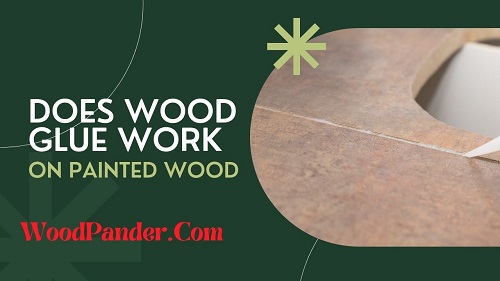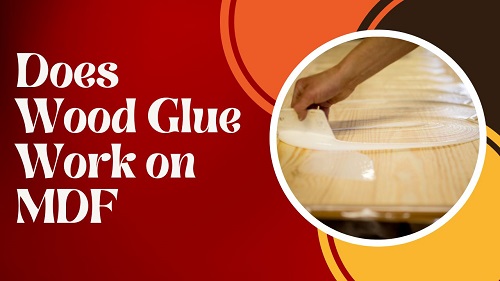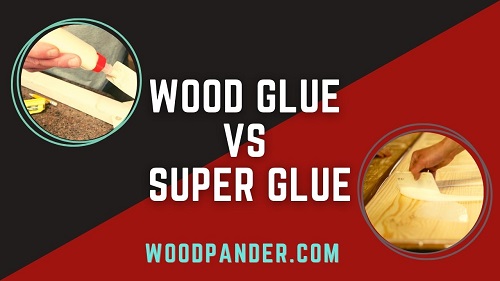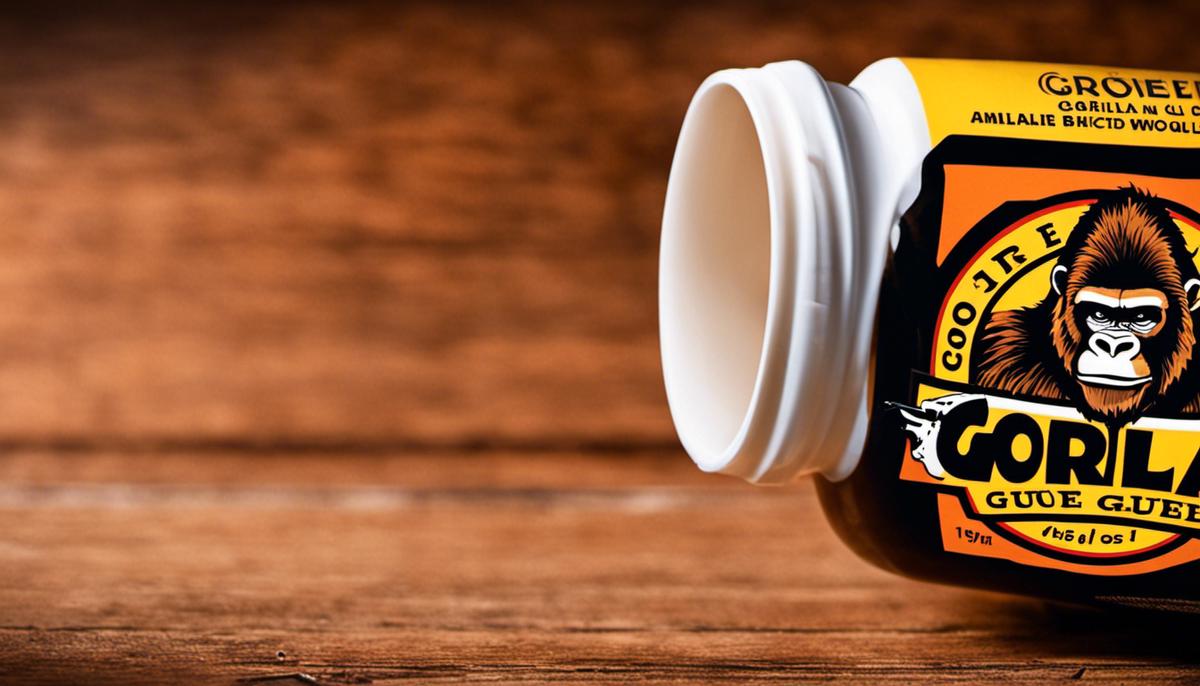Hot glue is a kind of glue that consists of thermoplastic polymers. That is often sold as solid cylindrical sticks of varying diameters intended for use with a hot glue gun
Now, if you want to know, does hot glue work on wood?
Yes, the hot glue can be applied to wood. At first, this glue is heated to meltdown at a specific temperature.After that, the glue is loaded into a glue gun. Then it is applied to the wood carefully. Next, another part of the wood is needed to place within 25-35 seconds. After doing that there is a period of 24 hours of drying.
But this is not enough for you. This content describes how hot glue works efficiently on wood. Therefore, you will get to know a lot more about glue.
That’s why if you are not busy, have a look at the entire article.
Different Types of Hot Glue that Works On Wood
It is essential to select the appropriate hot-glue adhesive for each use. Because the adhesive is required to complete a certain activity which might vary greatly. So, it is important to understand which adhesives are most suited for your task.
Therefore, We have listed down five types of glue that work on wood-
EVA (Ethylene Vinyl Acetate)
It is an original polymer base used mainly in standard packaging. It is also used in industrial hot melt adhesive.
This produces a very high-performing packaging hot melt glue. This glue is suitable for a wide range of activities. EVA works in both low temperature and standard temperature.
Polyethylene
These polymer bases work in most cases. Even in cartoon boxes and tray sealing, it provides light color & low odor.
However, it is not suitable for substances that are hard to bond. It is usually used in standard application temperatures.
Metallocene
Now, these types of glue were first introduced in the 1990s. It is made of combining polymers with other premium quality materials. This provides a really high stability.
This type of glue has higher stability both in high and cold temperatures. Nowadays, there are different types of metallocene in the market. It is advisable to check the original one before buying.
APAO (Amorphous Poly Alpha Olefins)
This type of adhesive is suitable where there is a long open time. It is mostly suitable for plastics. But you can use it on wood too.
These adhesives are sticky, soft, and have flexible textures. That’s why it becomes an excellent choice for product assembly.
Polyamides
Now, you might be wondering what is the best wood glue?
Well, among all the types of hot glue, polyamides are considered to be the best. Because polyamides adhesive excels where high-temperature resistance is desired. These types of glues are also suitable for quick assembly.
This makes this glue an excellent choice for applying on wood. Other critical assembly applications also prefer polyamides glue.
How Strong Is Hot Glue on Wood?
Hot glue is known for its versatility and strength, but how strong is it on wood?
Hot glue provides a strong bond on wood surfaces, making it suitable for various woodworking projects. It can withstand moderate stress and weight, making it ideal for lightweight applications such as crafts, decorations, and small repairs.
However, for heavy-duty or load-bearing projects, it is recommended to use wood glue or other specialized adhesives. Hot glue’s strength on wood also depends on factors such as the type of hot glue used and the surface preparation.
Overall, hot glue is a reliable adhesive for most wood applications, but it’s important to consider the specific project requirements.
Is Hot Glue Good For Wood?
Hot Glue On Wood: Using hot glue for wood projects can be a convenient and efficient option.
Hot glue guns are widely available and easy to use, making them a popular choice for DIY enthusiasts and crafters. When applied correctly, hot glue can provide a strong bond on wood surfaces, allowing you to create various projects such as small repairs, decorations, and crafts.
Limitations of Hot Glue on Wood: While hot glue is a versatile adhesive, it does have some limitations when it comes to wood. One limitation is its resistance to moisture.
Hot glue is not water-resistant, which means it may not hold up well in humid or wet environments. If your wood project will be exposed to moisture, it’s best to use a waterproof adhesive like wood glue or epoxy.
Another limitation is the temperature sensitivity of hot glue. Extreme heat or cold can cause hot glue to become brittle or lose its adhesive properties. Therefore, if your wood project will be exposed to temperature fluctuations, it’s important to consider using a more temperature-resistant adhesive.
Additionally, hot glue may not be suitable for heavy-duty or load-bearing applications on wood. It is best suited for lightweight projects that do not require significant strength or durability.
For projects that require a stronger bond, it is recommended to use wood glue or other specialized adhesives specifically designed for wood.
In summary, hot glue can be a good option for certain wood projects, especially those that are lightweight and do not require water resistance or high strength. However, it’s important to consider the limitations of hot glue and choose the appropriate adhesive based on the specific requirements of your project.
Best Hot Glue for Wood
When it comes to choosing the best hot glue for wood, there are several options available that provide strong and reliable adhesion. Here are six top-rated hot glue brands that are known for their effectiveness on wood surfaces:
Power Adhesive 7718: This hot glue is specifically designed for woodworking projects. It offers excellent bonding strength and is resistant to moisture, making it suitable for both indoor and outdoor applications.
Surebonder 739: Known for its versatility, Surebonder 739 is a popular choice among woodworkers. It provides a strong bond and is compatible with various types of wood, including hardwood and softwood.
AD Tech 962: This hot glue is known for its quick-drying properties, making it ideal for projects that require fast assembly. It offers a strong bond on wood surfaces and is suitable for both professional and DIY use.
Titebond: Titebond is a well-known brand in the woodworking industry, and their hot glue is no exception. It provides a strong and durable bond on wood, ensuring that your projects stay intact for a long time.
Polyurethane PUR Hot Melt Glue: This type of hot glue is ideal for bonding wood to other materials, such as metal or plastic. It offers excellent adhesion and is resistant to moisture, making it suitable for both indoor and outdoor applications.
Power Adhesive Tec Bond 23: Tec Bond 23 is a high-performance hot glue that offers exceptional bonding strength on wood surfaces. It is resistant to heat and moisture, making it suitable for a wide range of woodworking projects.
When choosing the best hot glue for wood, consider the specific requirements of your project, such as the type of wood, the level of moisture exposure, and the desired bond strength. By selecting the right hot glue, you can ensure a successful and long-lasting result for your woodworking projects.
Uses Of Hot Glue On Wood
Craft Projects and Decorative Touches:
Hot glue is a versatile adhesive that can be used for various craft projects on wood. Whether you’re creating a DIY wreath, making a picture frame, or adding decorative touches to furniture, hot glue provides a strong bond that holds your creations together.
Its quick-drying properties make it ideal for attaching embellishments like beads, buttons, and ribbons to wood surfaces.
Making Temporary Bonds:
Hot glue is also useful for making temporary bonds on wood. If you need to assemble or hold pieces together temporarily, hot glue can provide a strong and reliable hold.
This is especially handy for woodworking projects that require adjustments or disassembly later on.
Filling Gaps and Cracks:
Hot glue can be used to fill small gaps and cracks in wood. By applying hot glue to the affected area and smoothing it out, you can fill in imperfections and create a more seamless surface.
This is particularly useful for repairing minor damage or preparing wood surfaces for painting or staining.
Minor Repairs and Reinforcements:
Hot glue is great for minor repairs and reinforcements on wood. Whether it’s fixing loose joints, reinforcing weak spots, or repairing small chips or breaks, hot glue can provide a quick and effective solution.
It’s important to note that hot glue may not be suitable for heavy-duty repairs or structural integrity.
In summary, hot glue has a wide range of uses on wood, including craft projects, temporary bonds, filling gaps, and minor repairs. Its versatility and strong bonding properties make it a valuable tool for any woodworking enthusiast or DIYer.
Is Hot Glue Permanent or Temporary?
Hot glue can be used both as a temporary bond and as a permanent bond on wood. Understanding the difference between the two can help you determine the best application for your project.
Hot Glue as a Temporary Bond: Hot glue is an excellent choice for temporary bonds on wood. Its strong adhesive properties allow it to hold pieces together securely, but it can also be easily removed when needed.
This makes it ideal for woodworking projects that require adjustments or disassembly later on. Whether you’re working on a prototype, a temporary fixture, or a project that requires frequent changes, hot glue provides a reliable hold that can be easily undone without damaging the wood surface.
Hot Glue as a Permanent Bond:
While hot glue is primarily known for its temporary bonding capabilities, it can also create a permanent bond on wood.
The key to achieving a permanent bond with hot glue is to ensure proper surface preparation and application.
This includes cleaning the wood surface, removing any debris or oils, and applying the hot glue evenly and generously. Additionally, using a high-quality hot glue that is specifically designed for wood bonding can enhance the permanence of the bond.
Factors Affecting The Permanence Of Hot Glue:
Several factors can affect the permanence of hot glue on wood. These include the type and quality of the hot glue used, the surface preparation, the temperature and humidity conditions during application, and the stress or load placed on the bond.
It’s important to consider these factors when deciding whether to use hot glue as a permanent bond on wood. For projects that require long-term durability and strength, it may be more appropriate to use wood glue or other specialized adhesives.
In summary, hot glue can be used as both a temporary and permanent bond on wood. Its versatility and ease of use make it a popular choice for various woodworking projects.
However, it’s important to consider the specific requirements of your project and the factors that can affect the permanence of the bond.
Wood Glue vs Hot Glue
| Aspect | Wood Glue | Hot Glue |
|---|---|---|
| Adhesion | Strong bond specifically for wood | Versatile bonding for various materials |
| Application | Typically requires clamping for curing | Quick application; solidifies rapidly |
| Drying Time | Longer drying/curing time (hours) | Rapid cooling, sets within seconds |
| Strength | High bonding strength over time | Moderate strength; may weaken over time |
| Flexibility | Less flexible once dried and cured | Offers some flexibility |
| Heat Resistance | Generally less resistant to heat | Moderate heat resistance |
| Waterproof | Some wood glues are waterproof | Most hot glues are not waterproof |
| Usage | Primarily for woodworking projects | Crafts, DIY, temporary fixes |
When it comes to choosing between wood glue and hot glue for your woodworking projects, there are several factors to consider.
1. Strength and Durability:
– Wood Glue: Wood glue is specifically designed for bonding wood surfaces, providing a strong and durable hold. It forms a chemical bond with the wood fibers, creating a permanent connection.
– Hot Glue: Hot glue, on the other hand, offers a strong bond but may not be as durable as wood glue. It can withstand moderate stress and is suitable for temporary or lighter applications.
2. Drying and Clamping Time:
– Wood Glue: Wood glue requires clamping and drying time, which can range from a few hours to overnight. This allows the glue to fully cure and create a strong bond.
– Hot Glue: Hot glue, on the other hand, sets quickly within minutes, eliminating the need for clamping. It provides instant bonding, making it ideal for quick projects or repairs.
3. Flexibility and Reversibility:
– Wood Glue: Wood glue creates a rigid bond that is not easily reversible. Once cured, it is difficult to separate the bonded pieces without causing damage.
– Hot Glue: Hot glue offers more flexibility and reversibility. It can be easily softened and removed with heat, allowing for disassembly or adjustments.
4. Application and Cleanup:
– Wood Glue: Wood glue is applied using a brush, roller, or spreader. Excess glue can be wiped away with a damp cloth before it dries. Cleanup may require solvents.
– Hot Glue: Hot glue is applied using a glue gun, which allows for precise application. Any excess glue can be easily peeled or scraped off once it cools.
How To Apply Hot Glue On Wood?
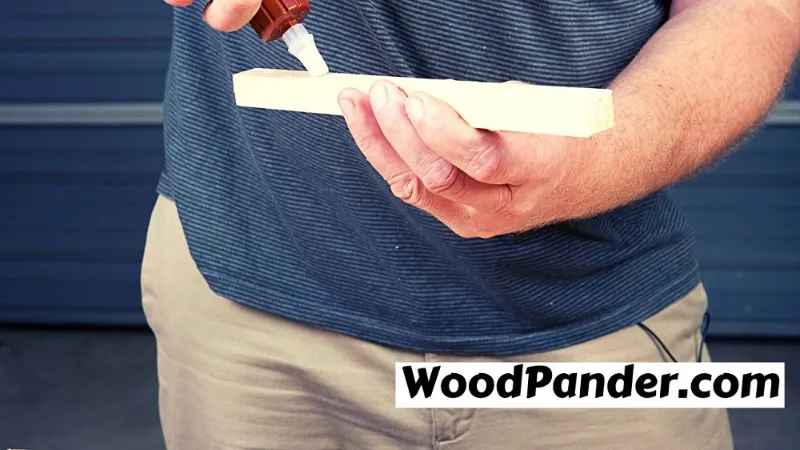
Hot Glue melts usually at a temperature of more than 100 º Celsius.
Thus, the glue is applied at a temperature of about 160º Celsius. The applying process of glue using the gun is mentioned below-
Process 1 of 3: Load The Glue Stick Gun
First, inspect the gun in order to use it properly. After that, make sure that the nozzle of the gun is free from old glue.
Now, load the glue from the backside of the glue gun. Then plug the gun into the electrical cord.
Process 2 of 3: Use The Gun On The Wood
At first, you have to wait for the glue to heat up. Then slightly release the trigger to apply the melted glue on the wood. Remember you have to refrain from using excessive glue.
This kind of glue usually has an open time of about 30-180 seconds. So, once you apply it on one piece of wood, make sure to attach the other piece quickly.
See Also: 1 Ton Of Coal Equals How Much Wood.
Process 3 of 3: Let the Glue Dry
In the last process, you have to let the wood dry. For the purpose of drying, 24 hours should be mandatory on average.
Here are the three processes on how to apply hot glue to wood. And also the types of hot glue. Hence, we hope you have found the answer you were looking for.
Tips for Using Hot Glue on Wood
When using hot glue on wood, it’s important to follow these tips for the best results:
1. Select the appropriate glue stick for wood projects.
2. Ensure that your wood surfaces are clean and free from dust or debris.
3. Warm up your wood slightly before applying the glue.
4. Use the right amount of glue to avoid excess or insufficient bonding.
5. Work quickly as hot glue tends to dry fast.
6. Be patient and allow the glue to fully set before handling the wood.
Does Hot Glue Work on Painted Wood?
When it comes to using hot glue on painted wood, there are a few things to consider.
First, make sure the paint is fully dry and cured before applying the hot glue. This will ensure a strong bond between the glue and the painted surface.
Additionally, it’s important to choose a hot glue that is compatible with painted surfaces. Look for a hot glue that is labeled as “paintable” or “compatible with painted surfaces.”
This will help to prevent any damage or discoloration to the paint. Overall, hot glue can work on painted wood as long as the proper precautions are taken.
Does Hot Glue Work on Damaged Wood?
When it comes to using hot glue on damaged wood, there are a few factors to consider. First, assess the extent of the damage. Hot glue is not a strong adhesive and may not be able to hold together severely damaged wood.
However, for minor cracks or chips, hot glue can provide a temporary fix. It’s important to note that hot glue is not a permanent solution for damaged wood and should be used as a temporary measure until proper repairs can be made.
Additionally, choose a hot glue that is compatible with wood surfaces for the best results.
Does Hot Glue Work on Metal to Wood?
Balsa wood is a popular material for crafting and model making due to its lightweight and easy-to-cut nature. But does hot glue work on balsa wood? The answer is yes! Hot glue is a great adhesive option for balsa wood projects. Its strong bond ensures that your pieces stay securely in place.
However, it’s important to note that hot glue may not be the best choice for load-bearing or structural applications with balsa wood. In such cases, using wood glue or epoxy would be more suitable.
Overall, hot glue is a versatile option for bonding balsa wood in various craft and hobby projects.
What Can You Use Instead of Hot Glue On Wood?
While hot glue is a versatile adhesive for wood, there are alternative options available if you don’t have access to hot glue or prefer to use something else. Two great alternatives to hot glue for wood are wood glue and epoxy.
Wood glue, also known as carpenter’s glue, is specifically designed for bonding wood surfaces. It creates a strong and durable bond that is ideal for woodworking projects.
Wood glue is available in different types, such as PVA (polyvinyl acetate) and polyurethane, each with its own set of advantages. PVA wood glue is easy to use, dries clear, and is suitable for most woodworking applications.
Polyurethane wood glue, on the other hand, provides a stronger bond and is more resistant to moisture and heat.
Epoxy is another excellent alternative to hot glue for wood. It consists of two components, a resin and a hardener, which need to be mixed together before application.
Epoxy creates an incredibly strong bond that is resistant to water, heat, and chemicals. It is particularly useful for bonding different types of wood, as well as wood to other materials like metal or plastic.
When choosing an alternative to hot glue for wood, consider the specific requirements of your project. Wood glue is great for woodworking applications, while epoxy offers superior strength and versatility. Both options provide reliable adhesion and are widely available in hardware stores.
Related Question
Can you put the hot glue on wood?
Yes you can. This glue is generally loaded inside a glue stick gun. Then the melting down process of the glue is carried out by the gun.
Is hot glue waterproof for wood?
The glue is waterproof. Unless it is not applied properly, the hot glue will be water-resistant.
What kind of glue works on wood?
PVA glues are excellent for use with porous materials such as wood. PVA wood adhesive is specifically designed to penetrate wood fibers. Which results in glue bonding that can be stronger than the wood itself. PVA glues make strong joins and keep wood looking good.
Why doesn’t hot glue stick on smooth surfaces?
The hot glue will penetrate woven textiles and fill cracks in rougher surfaces. And Solidify it to the surface as it cools. Smooth surfaces, such as metal, or greasy and oily surfaces, do not provide the hot glue with anything to connect. Hence the glue does not stick.
Can hot glue damage wood?
Hot glue generally does not damage wood when used properly. However, excessive heat or force during application or removal can potentially cause damage to the wood surface. It is important to use caution and apply the glue evenly without applying excessive pressure. When removing hot glue, take care to avoid scratching or gouging the wood.
Can hot glue be removed from wood?
Yes, hot glue can be removed from wood. One method is to use a heat gun or hairdryer to soften the glue, making it easier to peel off. Be careful not to overheat the wood or apply too much force, as this can damage the surface. Another option is to use isopropyl alcohol or acetone to dissolve the glue. Apply a small amount to a cloth and gently rub the glue until it loosens. It may take some time and patience, but with the right technique, hot glue can be removed from wood.
Do I need to prep the wood before using hot glue?
In most cases, prepping the wood before using hot glue is not necessary. However, if the wood surface is rough or dirty, it is recommended to clean and sand it before applying the glue. This will ensure a better bond and a smoother finish. Additionally, if the wood has been treated with a finish or paint, it is advisable to lightly sand the surface to create a better adhesive surface for the hot glue.
Conclusion
From the info above, every individual will know does hot glue work on wood or not.
Therefore, we hope that you’ve got your answer. We’ve tried to guide you to know everything about hot glue applying to wood.
Lastly, good luck using hot glue on your wooden items!

